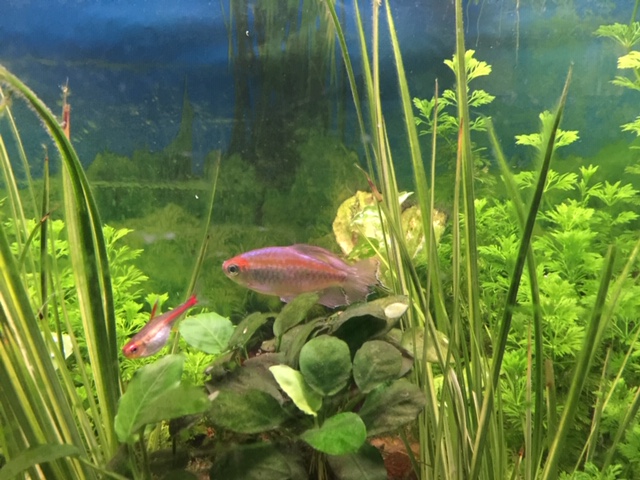Tetra
Characins Sub-Order Characoidei
Hardy And Attractive Aquarium Fish
A school of tetra fish really do look stunning in any tropical fish aquarium. There are many varieties with different characteristics and features.
These aquarium fish belong to a group called "Characins" and are found in many different places from South America to Africa.
They require a slightly varying degree of tank and water conditions and will also eat a combination of live food like worms, mosquito larvae and flake food.
Congo Tetra

Here's one of the most popular, the neon, with its blue and red highly attractive coloration schooling on YouTube.com...
Here's some other facts to help you keep tetra fish successfully...
* Most thrive in a water temperature of around 18-28 degrees celsius (Or roughly between 60-80 degrees Fahrenheit)...
* Most like plants with some shoaling (schooling) space...
* Most are roughly between 1.5 to 3 inches long (3 to 7 centimeters)...
* Many need "soft" water to help the breeding process...
* Most are excellent community fish for your aquarium...
* Most are omnivorous...
Here's a list of some of some types that many people keep in their aquarium...
- African Bloodfin
- Beacon
- Belgian flag
- Black Line
- Black Neon
- Black Wedge
- Bleeding Heart
- Blue
- Brass
- Buenos Aires
- Black Widow
- Bleeding Heart
- Cardinal
- Congo
- Costello
- Diamond
- Emperor
- Feather-Fin
- Flame
- Gilded
- Glowlight
- Jewel
- Lemon
- Neon
- Penguin
- Phantom
- Red Eye
- Red Nose
- Red Tailed
- Roberti
- Rosy
- Rummy nose
- Serpae
- Silver
- Splashing
- Spotted
- X-Ray
For more information on
tetra click here...
Breeding Tetra Fish Successfully
If you are keeping these types of fish, chances are you are breeding them, even if unknowingly.
In the wild they normally breed during the rainy season, but in the aquarium, they may breed year round.
Females are egg-scatters that typically fill with eggs every ten to fourteen days.
The female indiscriminately sprays her eggs into clumps of fine-leaved plants. The eggs are adhesive and stick to the plants.
However, they may often find the eggs and small fry an irresistible delicacy.
If breeding to keep them is your goal, the best thing to do is to separate males and females.
This allows you to keep control of breeding and improves your chance of achieving a successful hatch of fry.
Smaller species of female become sexually active at nine to twelve months old with larger species ready to breed at 1 ½ to 2 years of age.
Males are generally a month or two older than females for successful spawning to take place.
Males are typically slimmer and more colorful than their female companions are.
When viewed from above, the female tetra is distinguishable by its plumper and rounder body because of the build-up of eggs within her body.
Two weeks before breeding these fish, separate males and females within the same tank.
This is done simply by putting a clear divider between them, which not only gives you control of breeding but also stimulates spawning behavior since the fish are kept within sight of each other.
Breeding is also encouraged during the pre-spawn period by feeding them with high-quality live foods.
When ready to breed you’ll get the best results by using a separate breeding tank, prepared with a peat filter and clean, aged water in which clumps of fine-leaved plants have been strategically placed.
Three ways to complete your tank for breeding are:
* Drape the tank with nylon netting to allow the eggs to fall to the tank floor away from hungry adults.
*Cover the tank floor with marbles to hide the eggs and protect them from cannibalism.
*Plant fine-leaved plants or artificial spawning mops in seed trays filled with coarse gravel to trap the eggs and prevent them from being eaten.
Females should be placed in the breeding tank earlier than the males, usually the night before breeding.
In addition to allowing her to settle in, it also puts the male in the position of having to court her on her own turf.
This technique can deter any aggressive tendencies he may display.
After introducing the male to the breeding tank, it’s best to watch his introductory moves.
Males often show aggressive behavior during spawning. If the male attacks a female, remove her and re-separate the pair.
Another female can be tried or alternatively, two to three females can be introduced to the breeding tank to keep the male from focusing his attention on only one.
Remove adult fish from the breeding tank immediately after breeding.
I hope this page has helped you to understand tetra fish a little more and that you will include them in your tropical fish aquarium.
Enjoy!
Find More Info on the Tetra here...
If you are interested in Tetra Fish, on our site we have a free e-book available about these wonderful creatures.
Linda is author of Tetra Fish and Cichilds at https://www/aquarium-guides.com